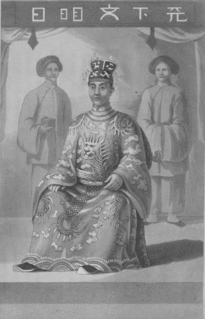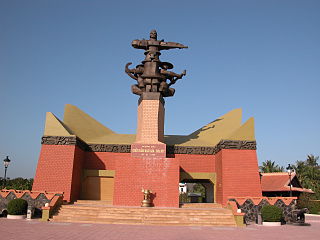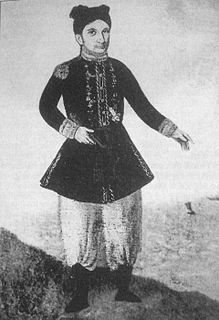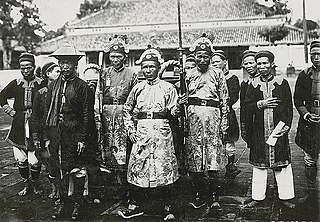
The Nguyễn dynasty was the last Vietnamese dynasty, which ruled the unified Vietnamese state largely independently from 1802 to 1884. During its existence, the empire expanded into modern-day southern Vietnam, Cambodia, and Laos through a continuation of the centuries-long Nam tiến and Siamese–Vietnamese wars. After 1883, the Nguyễn emperors ruled nominally as heads of state of the French protectorates of Annam and Tonkin until the final months of WWII; they later nominally ruled over the Empire of Vietnam until the Japanese surrender.

Gia Long, born Nguyễn Phúc Ánh (阮福暎) or Nguyễn Ánh, was the founding emperor of the Nguyễn dynasty, the last dynasty of Vietnam. His dynasty would rule the unified territories that constitute modern-day Vietnam until 1945.

Minh Mạng or Minh Mệnh was the second emperor of the Nguyễn dynasty of Vietnam, reigning from 14 February 1820 until his death, on 20 January 1841. He was the fourth son of Emperor Gia Long, whose eldest son, Nguyễn Phúc Cảnh, had died in 1801. He was well known for his opposition to French involvement in Vietnam and his rigid Confucian orthodoxy.

The Tây Sơn dynasty (Vietnamese: [təj ʂəːn], Vietnamese: Nhà Tây Sơn ; Vietnamese: Tây Sơn triều was a ruling dynasty of Vietnam, founded in the wake of a rebellion against both the Nguyễn lords and the Trịnh lords before subsequently establishing themselves as a new dynasty. The Tây Sơn were led by three brothers, referred to by modern Vietnamese historians as the Tây Sơn brothers because of their origin in the district of Tây Sơn.

The Catholic Church in Vietnam is part of the worldwide Catholic Church, under the spiritual leadership of Bishops in Vietnam who are in communion with the Pope in Rome. Vietnam has the fifth largest Catholic population in Asia, after the Philippines, India, China and Indonesia. There are about 7 million Catholics in Vietnam, representing 7.0% of the total population. There are 27 dioceses with 2,228 parishes and 2,668 priests. The main liturgical rites employed in Vietnam are those of the Latin Church.

The Nguyễn lords, also known as the Nguyễn clan, were rulers of Đàng Trong in Central and Southern Vietnam also known as Cochinchina, as opposed to Đàng Ngoài or Outer Realm, ruled by the Trịnh lords.

The Battle of Rạch Gầm-Xoài Mút was fought between the Vietnamese Tây Sơn forces and an army of Siam in present-day Tiền Giang Province on January 20, 1785. It is considered one of the greatest victories in Vietnamese history.
Võ Tánh was an 18th-century Vietnamese military commander, best known for his role as a general of Nguyễn Ánh, who unified modern-day Vietnam and ruled as Emperor Gia Long.

Phan Thanh Giản was a Grand Counsellor at the Nguyễn court in Vietnam. He led an embassy to France in 1863, and committed suicide when France completed the invasion of Southern Vietnam (Cochinchina) in 1867.
Philippe Vannier was a French Navy officer and an adventurer who went into the service of Nguyễn Ánh, the future emperor Gia Long of Vietnam.

French assistance to Nguyễn Phúc Ánh, the future founding emperor of the Nguyễn dynasty, covered a period from 1777 to 1820. From 1777, Mgr Pigneau de Behaine, of the Paris Foreign Missions Society, had taken to protecting the young Vietnamese prince who was fleeing from the offensive of the Tây Sơn. Pigneau de Behaine went to France to obtain military aid, and secured a France-Vietnam alliance that was signed through the 1787 Treaty of Versailles between the king of France, Louis XVI, and Prince Nguyễn Phúc Ánh. As the French regime was under considerable strain at the eve of the French Revolution, France was unable to follow through with the application of the treaty. However, Mgr Pigneau de Behaine persisted in his efforts and, with the support of French individuals and traders, mounted a force of French soldiers and officers that would contribute to the modernization of the armies of Nguyễn Ánh, making possible his victory and his reconquest of all of Vietnam by 1802. A few French officers would remain in Vietnam after the victory, becoming prominent mandarins. The last of them left in 1824 following the enthronement of Minh Mạng, Gia Long's successor. The terms of the 1787 Treaty of Alliance would still remain one of the justifications of French forces when they demanded the remittance of Đà Nẵng in 1847.
Đỗ Thanh Nhơn was an 18th-century Vietnamese military commander.

Lê Văn Duyệt was a Vietnamese general who helped Nguyễn Ánh—the future Emperor Gia Long—put down the Tây Sơn wars, unify Vietnam and establish the Nguyễn Dynasty. After the Nguyễn came to power in 1802, Duyệt became a high-ranking mandarin, serving under the first two Nguyễn emperors Gia Long and Minh Mạng.

Nguyễn Nhạc was the founder of the Tây Sơn dynasty, reigning from 1778 to 1788.
Laurent-André-Estiennet-Marie Barisy was an adventurer who went into the service of Nguyễn Ánh, the future emperor Gia Long of Nguyễn dynasty, Vietnam.
The Tây Sơn Rebellion was a massive peasant rebellion and an interregnum in the late eighteenth century Dai Viet against the ruling Vietnamese elites and monarchs, during the context of a 250-year-long disintegration period. The rebellion was led by three Tayson brothers, Nguyễn Nhạc, Nguyễn Huệ, and Nguyễn Lữ, who eventually overthrew all ruling clans and the reigning Lê dynasty in southern and northern Dai Viet.
The Vietnamese invasions of Cambodia refers to the period of Cambodian history, between 1813 and 1845, when the Kingdom of Cambodia was invaded by the Kingdom of Vietnam three times, and a brief period from 1834 to 1841 when Cambodia was a Vietnamese province, undertaken by Vietnamese emperors Gia Long and Minh Mạng. The first invasion that took place in 1811-1813 put Cambodia as Vietnam's client kingdom. The second invasion in 1833–1834 made Cambodia a de facto Vietnamese province. Minh Mạng's harsh rule of the Cambodians finally ended after he died in early 1841, an event which coincided with a Cambodian rebellion, and both which triggered a Siamese intervention in 1842. The unsuccessful third invasion of 1845 resulted in the independence of Cambodia. Siam and Vietnam signed a peace treaty in 1847, allowing Cambodia to reassert its independence in 1848.

The military of the Nguyễn dynasty were the main military forces of the Nguyễn dynasty from 1802 to August 1945 when it was dismantled by the August Revolution. The Nguyễn military force was initially formed by Nguyễn Hoàng as a division of the military of the Revival Lê dynasty in 1558 starting out with 3000 soldiers. During this period it was the military forces of the domain of the Nguyễn lords and commonly fought the Trịnh lords who controlled northern Vietnam. During the Tây Sơn Rebellion it was expelled out most of the county by the Tây Sơn dynasty. After the exiled Nguyễn Phúc Ánh returned and defeated the Tây Sơn rebels he crowned himself as the Gia Long Emperor and the Nguyễn military became the national military of Vietnam.

The French conquest of Vietnam (1858–1885) was a long and limited war fought between the Second French Empire, later the French Third Republic and the Vietnamese empire of Đại Nam in the mid-late 19th century. Its end and results were victories for the French as they defeated the Vietnamese and their Chinese allies in 1885, the incorporation of Vietnam, Laos, and Cambodia, and finally established French rules over constituent territories of French Indochina over Mainland Southeast Asia in 1887.

The Vietnamese Civil War of 1787–1802, or the Tây Sơn–Nguyễn Civil War of 1787–1802, was a conflict fought between two Vietnamese factions, the Tayson in the north, and the Nguyen loyalists in the south, both intended to unify the realm. Following the Tây Sơn rebellion (1771–1789), the kingdom of Dai Viet was partitioned into three regions unionized by the Tây Sơn brothers Nguyen Nhac, Nguyen Hue and Nguyen Lu. Nguyen Phuc Anh, a Nguyen Prince and descendant of the annihilated Nguyen lord family that once been overthrown by the Tây Sơn in the 1770s, returned to Vietnam in 1787 after spending years of exile in Siam, to rally loyalists for his support against the Tây Sơn. With intercessions from his Alliance, Nguyen Anh and the Nguyen loyalists effectively defeated the Tây Sơn, dismantled the Tây Sơn regime, conquered the whole realm, and established the unified Vietnamese state in 1802.
















